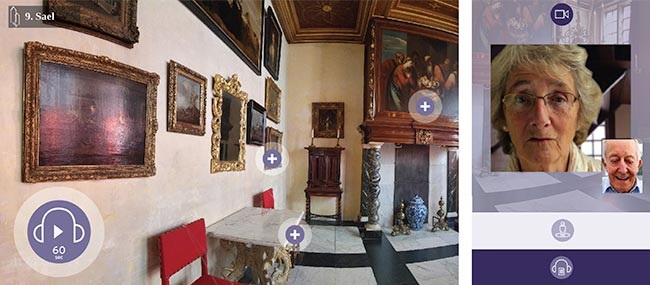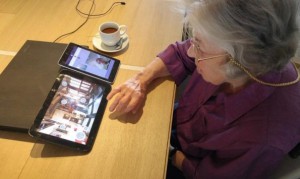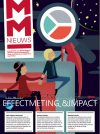
CoVisit in Ons Lieve Heer op Solder
Visitors rarely come to a museum alone. Most people arrive in couples or groups of family or friends. A shared museum visit is a more pleasurable experience, often a heightened experience. Objects are admired and appraised together. In discussion, simple information becomes personalized knowledge. We take such shared moments for granted.
A shared museum experience is not a given for the mobility-impaired. Particularly in older cultural heritage sites, the mobility-impaired are often restricted to modern visitor reception areas. Neighbouring, original areas remain inaccessible, due to steep staircases, narrow corridors, and the non-availability of lifts. Despite the best efforts of the museums themselves, the mobility-impaired often still have to make do with reading or multimedia material in reception areas, whilst their partners visit the ’authentic‘ sites.
Inaccessible heritage
The Ons’ Lieve Heer op Solder Museum in Amsterdam faced just such a problem. The refurbishment of an additional museum building, adjacent to the old museum, has provided a rich palette of new services – educational facilities, a café, the opportunity to exhibit rarely seen historical artefacts. All spaces on all floors in the new building are accessible by lift, and can therefore be enjoyed and shared by all. But the jewel of the museum – the remarkable 16th century ‘hidden church’ (Dutch: schuilkerk) Het is eigenlijk geen schuilkerk, maar ‘gewoon ‘een zolderkerk ‘attic church’) in the original building – still remains out of bounds to the mobility-impaired, as it can only be reached via vertiginous and narrow staircases.
How could Ons’ Lieve Heer provide the full, shared museum experience to the mobility-impaired visitor in such a situation? The museum posed this question as an open assignment to Janine Huizenga and Andrew Bullen of the Creative Cooperative, who provided an innovative answer.
Huizenga:
We intentionally avoided the currently popular Virtual Reality (VR) approach to the remote museum visit, as our own knowledge and our subsequent research very much strengthened our belief that museum visitors prefer the interaction and dialogue of a shared museum visit, albeit digitally mediated, as opposed to the essentially 'isolated' digital VR experienceTele-presence
Creative Cooperative developed a solution which allows a mobility-impaired visitor in a remote location to share a museum experience with a ‘local‘ visitor, who is physically making a tour of the museum. This implies a shared museum experience mediated through tele-presence and the availability of different digital media and content to each of the respective users. The project also aimed to research and test whether this form of shared experience may not only “compensate” for the lack of physical presence of the remote visitor in the museum but may actually also enhance the value of the visit for both users, local and remote.
“We intentionally avoided the currently popular Virtual Reality (VR) approach to the remote museum visit, as our own knowledge and our subsequent research very much strengthened our belief that museum visitors prefer the interaction and dialogue of a shared museum visit, albeit digitally mediated, as opposed to the essentially ‘isolated’ digital VR experience”, says Huizenga.
Family visits 2.0
 A co-creative approach was central to the whole project process: from initial research into user behaviour, through the concept and design phase, to prototyping and testing of the product. To this end, the development team worked closely with a group of elderly and enthusiastic museum visitors. Although the co-creative group was led by the design team with regard to development process and tools, the input of each member of the group was considered and evaluated on an equal basis. This approach led, for example, to considerably increased insight into the desired shared experience of the users and the physical factors around the experience.
A co-creative approach was central to the whole project process: from initial research into user behaviour, through the concept and design phase, to prototyping and testing of the product. To this end, the development team worked closely with a group of elderly and enthusiastic museum visitors. Although the co-creative group was led by the design team with regard to development process and tools, the input of each member of the group was considered and evaluated on an equal basis. This approach led, for example, to considerably increased insight into the desired shared experience of the users and the physical factors around the experience.
The necessity of continuous, high-level connectivity for interaction and dialogue between the local and remote visitors also demanded close collaboration with the technical experts: partial re-architecting and reinforcement of the museum Wi-Fi network was necessary to guarantee the connection quality.
The launch of the CoVisit prototype has proved to be a great success, with elderly visitors eager to make the tour with friends and family, and particularly to involve their ’tech-savvy’ grandchildren as partners. Further plans involve the transfer of the CoVisit to the internet, thus making planned co-visits also available for educational institutes worldwide. Technology is changing the museum world and bringing access to a rich heritage to an even greater audience, but on a very human scale.
 [UITGEVER:] Dit artikel is onderdeel van de Special Edition voor de BMC CultuurConferentie 2016 over Participatie en Community building.
[UITGEVER:] Dit artikel is onderdeel van de Special Edition voor de BMC CultuurConferentie 2016 over Participatie en Community building.
